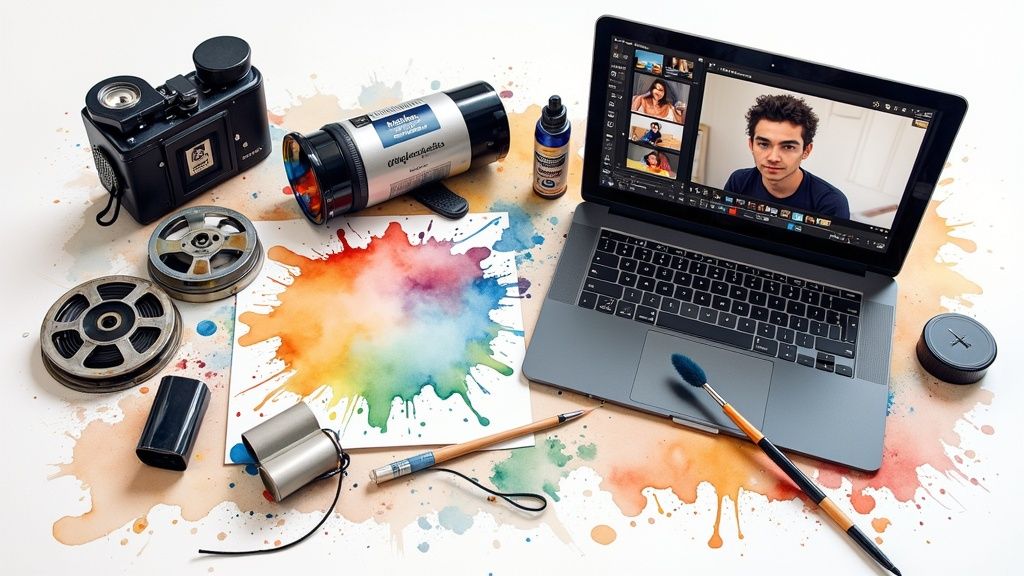The Evolving Landscape of Social Media Video Content

The way people consume content on social media has fundamentally changed. Videos now dominate feeds that were once filled with photos and text updates. This major shift means brands and creators need fresh approaches to video creation and editing, as traditional content methods no longer capture attention like they used to.
Why Video is King
Videos excel at storytelling in ways that static content simply cannot match. When done well, video creates an emotional connection with viewers and keeps them engaged longer. Social media platforms have noticed this effect - they actively promote video content in their algorithms, giving it better reach and visibility. But success requires more than just posting any video - you need to understand the specific requirements and best practices for each platform.
The Rise of Advanced Editing Tools
The growing demand for polished video content has sparked massive growth in the video editing software market. Current data shows the market valued at $3.09 billion in 2023, with projections reaching $5.13 billion by 2032 - that's a 5.8% annual growth rate. More creators are investing in these tools, with paid users expected to jump from 43 million to 63.59 million by 2030. The average yearly subscription cost is also climbing, from $105 to $149.13 in that same period. For more insights, check out these detailed video editing software statistics. These numbers clearly show how video editing has become essential for social media success.
Adapting to a Video-First World
To thrive in this video-focused environment, creators need to make video central to their content strategy, not just an occasional add-on. This means mastering engaging storytelling techniques and learning platform-specific optimization. For helpful tips, see this guide on mastering social media video best practices. The key to standing out lies in understanding each platform's sweet spots - from ideal video length to aspect ratios - and using those insights to create content that grabs and holds viewer attention.
Selecting and Mastering Your Video Editing Arsenal

Success on social media starts with building the right video editing toolkit. Rather than chasing expensive software, focus on tools that match how you work and what you want to achieve on each platform. Your toolkit can range from basic mobile apps to full-featured desktop programs.
Mobile-First Editing: Quick and Effective
Many creators start with mobile editing as their foundation. Apps like InShot, CapCut, and VN pack impressive features into your phone - from basic cuts and transitions to text overlays and color adjustments. This makes it simple to create engaging content anywhere, which is especially valuable for TikTok and Instagram Stories where timing matters most.
Stepping Up to Desktop Software
As your content grows more complex, desktop video editing software offers deeper capabilities. Industry standards like Adobe Premiere Pro, Final Cut Pro, and DaVinci Resolve give you precise control over color grading, motion graphics, and audio mixing. Just keep in mind that these tools take time to master and cost more upfront. For more details, check out our guide to the best video editing software for social media.
Finding the Right Balance: Efficiency vs. Complexity
Your choice of tools depends on your specific needs. Ask yourself: Do you need quick edits for short clips, or detailed post-production for longer content? For instance, if you're a travel vlogger posting daily updates, speed is key - stick with mobile apps. But if you're creating weekly documentary-style YouTube videos, desktop software's advanced features will serve you better.
Building a Sustainable Workflow
The most practical approach is often a mix of tools. Many successful creators edit initial cuts on their phones, then polish the final version on desktop. This gives you the speed to stay consistent with posting while maintaining high quality. Think of it as getting the best of both quick turnaround and professional polish.
The Importance of Audio
No matter which tools you choose, high-quality audio makes or breaks your content. Clear sound instantly makes videos more engaging and professional. Getting a good microphone for your phone or computer is worth every penny - it's often the single biggest upgrade you can make to your production value. Planning your audio strategy from the start saves countless hours fixing sound issues during editing.
Platform-Specific Mastery: Optimizing for Maximum Impact

Creating great social media videos requires understanding the unique characteristics of each platform. When you adapt your editing approach to match how people use TikTok, Instagram, Facebook, and YouTube, your content resonates more strongly and performs better. Let's explore how to effectively edit videos for each major platform.
Understanding Platform Nuances
Every social platform has developed its own distinct content style and viewer preferences. TikTok users love quick, energetic clips with trending music and rapid transitions. Instagram emphasizes polished visuals and engaging stories through both short Reels and longer IGTV videos. YouTube gives creators more room to develop in-depth content, from detailed tutorials to long-form entertainment. Getting these platform differences right makes your videos feel native to each environment.
The numbers show just how much video impacts social media success. 87% of marketers have seen their sales grow through video content. On Facebook, users spend 50% of their time watching videos, with live videos getting three times more engagement than other posts. It's no surprise that 86% of marketers now use Facebook for video marketing. Check out more data in these social media video statistics from Sprout Social. This shows why mastering platform-specific editing is key for growing your audience and reaching your goals.
Tailoring Your Editing Style
Each platform needs its own editing approach to keep viewers watching. TikTok thrives on snappy transitions, quick cuts, and trending sounds that grab attention fast. Instagram users expect smooth, visually appealing edits with attractive color grading and graphics. YouTube allows for deeper storytelling through more complex editing techniques. While adapting to each platform, maintain consistent branding that viewers recognize across all your content.
Practical Optimization Strategies
Here's how to optimize your videos for each major platform:
- TikTok: Create brief, punchy content using trending music, text overlays, and fast-paced editing
- Instagram: Focus on visual appeal through careful color grading and smooth transitions in both Reels and IGTV
- Facebook: Mix different video types including live content, and always add captions since many watch without sound
- YouTube: Build clear story arcs and use chapters to help viewers navigate longer videos
Testing and Refining
Track your video performance data across platforms to see what works best. Use these insights to keep improving your editing style for each platform's audience. Remember that great social media video editing comes from constantly learning and adjusting based on what engages your viewers. Stay open to trying new approaches as platforms and viewer preferences evolve.
Crafting Videos That Stop the Scroll
Creating scroll-stopping videos is essential for standing out on social media feeds. Just like an eye-catching store window makes people stop and look, your video's opening moments need to pull viewers in immediately. Let's explore how to make videos that capture attention and keep audiences watching.
The Crucial First Three Seconds
Those initial three seconds are make-or-break time for your video. Think about your own social media habits - you quickly decide whether to keep watching or scroll past. Your opening needs to pack a punch with visually striking elements while clearly showing viewers what value they'll get from watching. For example, start with an unexpected visual, ask an intriguing question, or preview an impressive end result.
Editing Techniques to Maintain Engagement
After hooking viewers, smart editing keeps them watching through:
- Dynamic Pacing: Mix up your editing speed like a good DJ mixes music - alternate between quick cuts and slower moments to maintain interest
- Jump Cuts: Remove dead space and create energy by cutting between closely related shots, perfect for platforms like TikTok
- Sound Design: Choose music and effects that enhance the emotional impact, just as movie soundtracks do
- Visual Elements: Add text overlays, emojis, and graphics to highlight key points and engage viewers watching without sound
Storytelling Frameworks for Social Media
Even short videos need a strong story structure. Here are three proven frameworks:
- Hook-Story-Offer: Begin with an attention-grabbing hook, tell a quick story, then end with a clear next step for viewers
- Problem-Solution: Show a common challenge, then reveal how to solve it - great for how-to and tutorial content
- Before-and-After: Display transformations that catch the eye and prove results, from room makeovers to skill improvements
Adapting Techniques Across Platforms
Different platforms need different approaches. The rapid pace of TikTok videos won't work the same way on YouTube, where viewers expect more detailed content. Study what performs well on each platform and adjust your editing style accordingly. Pay attention to typical video lengths, popular transitions, and how top creators structure their content for each specific platform.
Advanced Editing Techniques for Professional Results

Creating eye-catching social media videos requires mastering key editing skills that go beyond basic cuts and transitions. The right editing techniques can turn simple footage into polished, engaging content that resonates with viewers. Let's explore the essential elements of professional video editing - from color grading to sound design and motion graphics.
Mastering Color Grading
Color grading is much more than just fixing exposure and white balance. It's about purposefully shaping the visual mood and drawing attention to key elements in your scenes. Think of it like crafting a signature visual style through careful adjustment of contrast, saturation, and color balance. Many editors also use color lookup tables (LUTs) as creative shortcuts - for example, applying a muted, warm tone for a vintage feel or pumping up cool tones and vibrancy for a modern edge.
The Power of Sound Design
Great visuals need equally great audio to make an impact. Sound design starts with clean, balanced dialogue and narration but extends to thoughtful use of music and effects. For instance, an energetic music track can amplify exciting moments, while subtle ambient sounds create atmosphere and depth. Even small touches like a gentle whoosh sound during transitions can add polish and keep viewers engaged. The right audio choices emotionally connect with your audience and reinforce your message.
Enhancing with Motion Graphics
Motion graphics take your videos from basic to professional by adding dynamic visual elements. These can be as simple as animated text overlays that highlight key points or as complex as full custom animations. For example, you might use motion graphics to smoothly reveal statistics, emphasize your call-to-action, or create eye-catching scene transitions. Even simple animated elements make your content more visually interesting and help key information stand out.
Developing Your Unique Visual Style
The most successful content creators have a distinctive look that makes their work instantly recognizable. By combining color, sound, and motion graphics in consistent ways, you develop your own signature style. Look at popular creators in your niche - you can often identify their videos just from the editing approach. This visual consistency helps build your brand and makes your content more memorable.
Practical Tips for Implementation
- Start Small: Pick one technique like color grading to focus on first before adding more complex elements
- Experiment: Test different combinations of effects and styles to find what fits your brand
- Practice: Set aside time to edit regularly and refine your techniques through repetition
- Seek Inspiration: Study content you admire and break down the editing techniques that make it effective
With dedicated practice of these editing techniques, you can create social media videos that capture attention, engage viewers, and effectively communicate your message. The key is starting simple and gradually building your skills over time.
Data-Driven Content Optimization
How do you know if your social media videos are actually working? The key lies in continuously tracking performance data, testing different approaches, and adapting your editing based on what the numbers tell you. Let's explore how to make smart, data-backed decisions about your video content.
Understanding Engagement Metrics
Your first step is identifying what actually matters when measuring video performance. Key metrics to track include:
- Watch time: How long viewers stay engaged
- Audience retention: Where people drop off
- Click-through rate (CTR): How often thumbnails lead to views
- Engagement: Likes, comments, and shares
Each social platform provides analytics that show how viewers interact with your content. For instance, if you notice most viewers leave within the first 15 seconds, your intro may need to be more engaging.
Turning Data into Actionable Insights
Raw numbers only become valuable when you use them to make better content. Look for patterns - if your behind-the-scenes videos consistently get more engagement, that's a signal to create more of that content. On the flip side, high drop-off rates might mean your pacing needs adjustment. Want to learn more? Check out How to create video content for social media - a proven success framework.
A/B Testing for Optimal Performance
Testing different elements is essential for improving your videos. Try varying:
- Thumbnail designs
- Intro lengths and styles
- Music choices
- Editing pace
Track which versions perform better and apply those learnings to future videos.
Case Studies: Learning from the Best
Many successful YouTubers obsessively analyze their video performance data. They track exactly which moments keep viewers watching and which cause drop-offs. This helps them continually refine their content approach based on what actually works for their audience.
Building Your Optimization System
Create a simple but consistent process for tracking your video performance:
- Set a weekly or bi-weekly schedule to review analytics
- Keep a spreadsheet of key metrics
- Note patterns and trends over time
- Make specific adjustments based on the data
The numbers show why this matters: Video marketing generates 66% more qualified leads than traditional methods. 93% of companies report gaining new customers through video content, and 91% of marketers see increased website traffic. For videos under two minutes, 77% of viewers watch until the end when the content quality ranks in the top 5%. See more stats here.
Remember, improving your videos is an ongoing process. Keep testing, measuring, and refining your approach based on what the data shows works best for your audience.
Ready to make data-driven video creation easier? Check out Aeon, an AI-powered platform that helps publishers create engaging video content more efficiently.